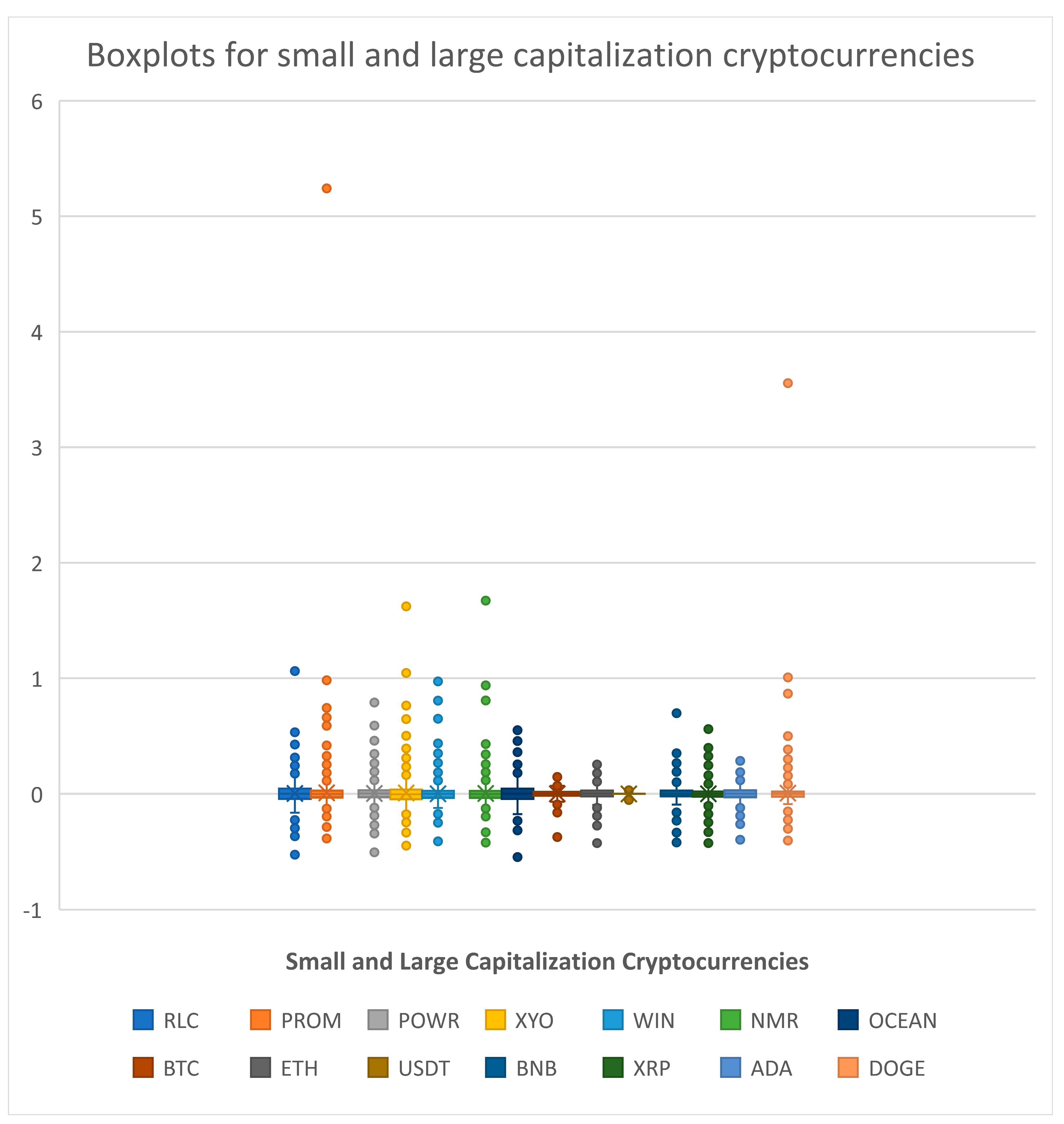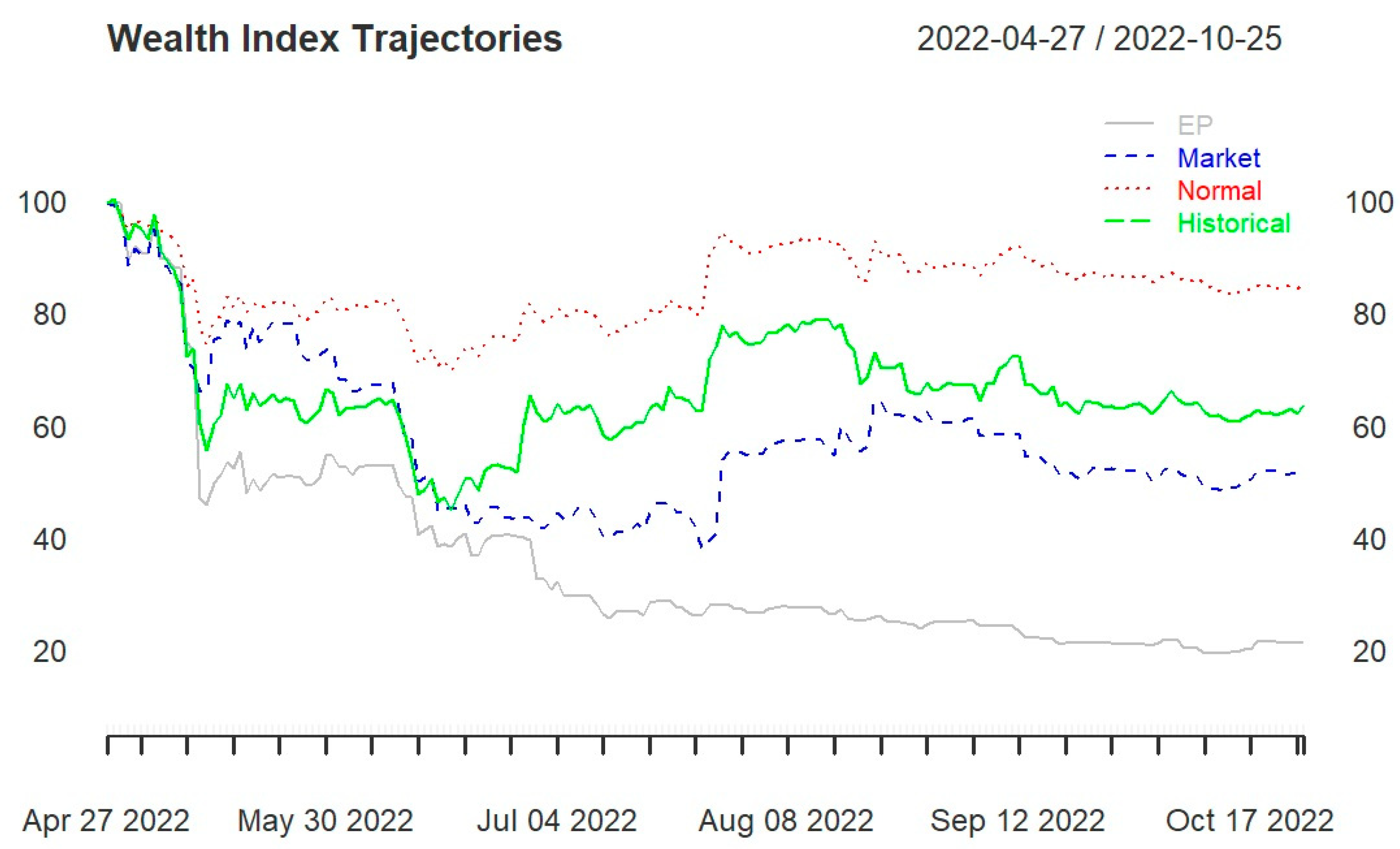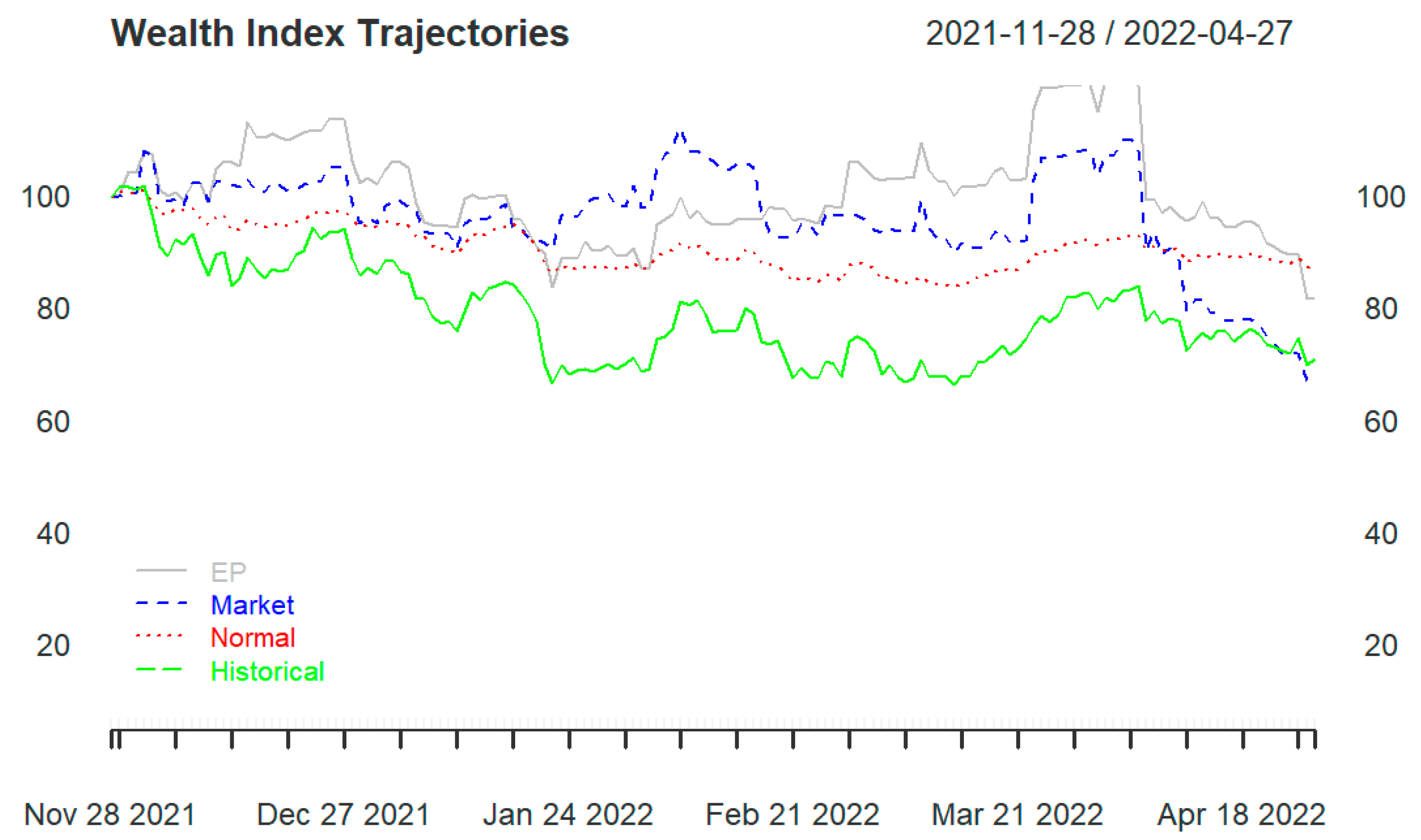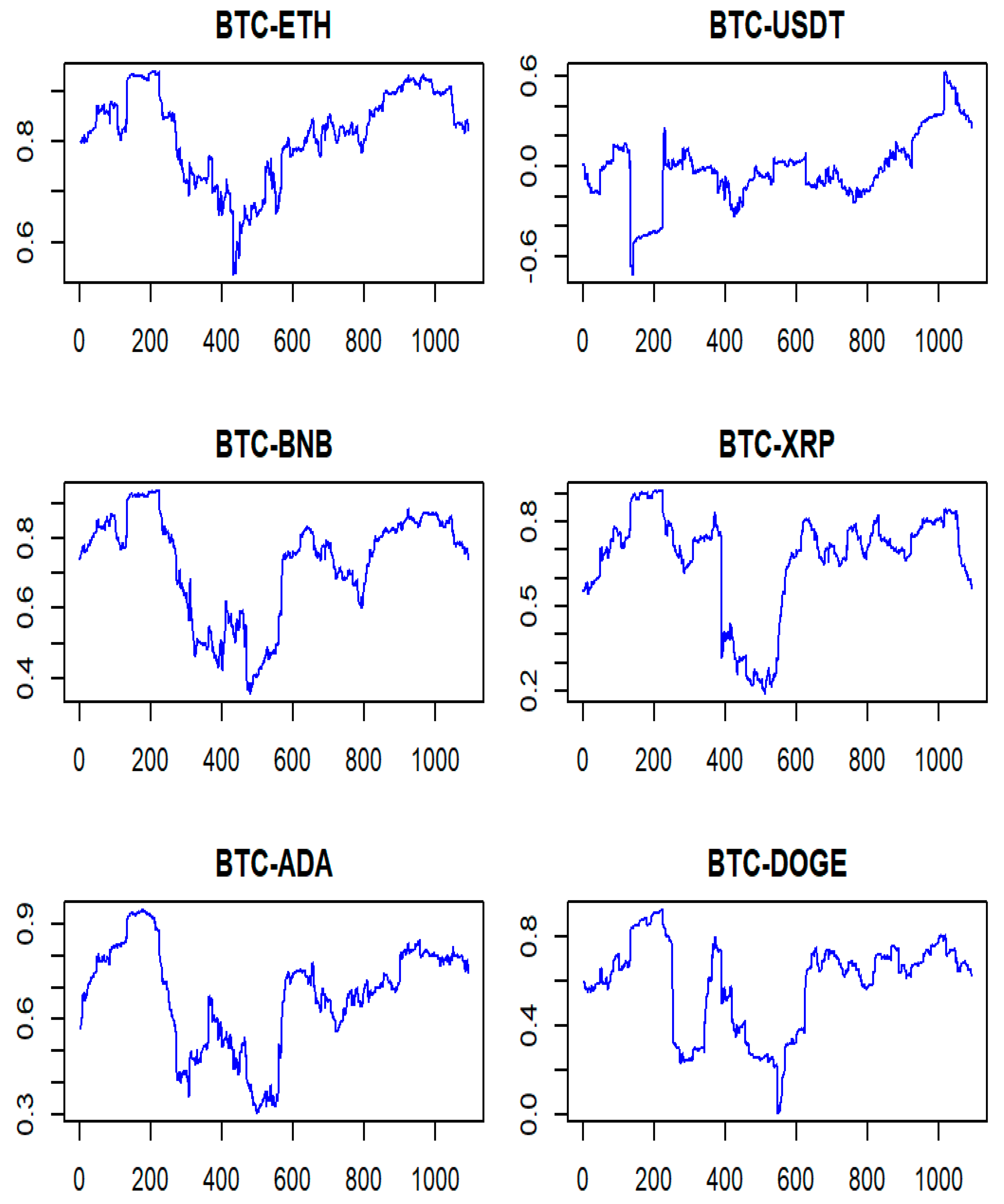A K-Means Classification and Entropy Pooling Portfolio Strategy for Small and Large Capitalization Cryptocurrencies
Abstract
:1. Introduction
2. Literature Review
3. Methodology
3.1. K-Means Clustering Algorithm
| Algorithm 1. K-means algorithm |
| Input: the number of clusters to be formed the training set ( data matrix) Output:
|
3.2. Entropy Pooling
- We assume that a set of random variables , which has a priori joint distribution, , can be used to model the market for C assets. denotes the securities’ return but is not limited to these market factors.
- We assume that the fitted data follows a particular distribution, and we use Monte Carlo simulation to detrmine simulated values for the market distribution. A matrix of dimensions () is then obtained, where represents the marginal prior distributions and denotes the simulated results for the market factors. To further indicate that each Monte Carlo draw has an identical probality, we associate the probability with each of the outcomes and set the probabilities to be equal to .
- We express the views based on a set of linear inequality constraints, , where the probability vector is regarded as the objective variable in the following optimization. We obtain the lower and upper bounds and the matrix from .
- The next step is to minimize the relative entropy. The (discrete) objective function is defined as
- In the last step, we find the empirical confidence-weighted posterior distribution ( as follows:
3.3. GARCH Model
4. Results and Analysis
4.1. Data and Descriptive Statistics
4.2. Empirical Results and Analysis
4.3. Performance Measure Analysis
4.4. Sensitivity Test
5. Conclusions
Author Contributions
Funding
Data Availability Statement
Acknowledgments
Conflicts of Interest
References
- Demiralay, S.; Bayracı, S. Should stock investors include cryptocurrencies in their portfolios after all? Evidence from a conditional diversification benefits measure. Int. J. Financ. Econ. 2021, 26, 6188–6204. [Google Scholar] [CrossRef]
- Cryptocurrency Prices, Charts and Market Capitalizations|CoinMarketCap 2022. Available online: https://coinmarketcap.com/ (accessed on 13 November 2022).
- Estalayo, I.; Del Ser, J.; Osaba, E.; Bilbao, M.N.; Muhammad, K.; Gálvez, A.; Iglesias, A. Return, Diversification and Risk in Cryptocurrency Portfolios using Deep Recurrent Neural Networks and Multi-Objective Evolutionary Algorithms. In Proceedings of the IEEE Congress on Evolutionary Computation, Wellington, New Zealand, 10–13 June 2019; pp. 755–761. [Google Scholar]
- Lorenzo, L.; Arroyo, J. Analysis of the cryptocurrency market using different prototype-based clustering techniques. Financ. Innov. 2022, 8, 2–46. [Google Scholar] [CrossRef]
- Kim, S.; Sarin, A.; Virdi, D. Crypto-assets unencrypted. J. Investig. Manag. 2018, 16, 99–129. [Google Scholar]
- Letho, L.; Chelwa, G.; Alhassan, A.L. Cryptocurrencies and portfolio diversification in an emerging market. China Financ. Rev. Int. 2022, 12, 20–50. [Google Scholar] [CrossRef]
- Markowitz, H. Portfolio Selection. J. Financ. 1952, 7, 77–91. [Google Scholar]
- Pfiffelmann, M.; Roger, T.; Bourachnikova, O. When behavioral portfolio theory meets Markowitz theory. Econ. Model. 2016, 53, 419–435. [Google Scholar] [CrossRef]
- Malkiel, B.G. A Random Walk down Wall Street the Time-Tested Strategy for Successful Investing; WW Norton & Company: New York, NY, USA, 2019. [Google Scholar]
- Mangram, M.E. A simplified perspective of the Markowitz portfolio theory. Glob. J. Bus. Res. 2013, 7, 59–70. [Google Scholar]
- Platanakis, E.; Urquhart, A. Should investors include bitcoin in their portfolios? A portfolio theory approach. Br. Account. Rev. 2019, 52, 100837. [Google Scholar] [CrossRef]
- Lee, D.K.C.; Guo, L.; Wang, Y. Cryptocurrency: A new investment opportunity? J. Altern. Investig. 2017, 20, 16–40. [Google Scholar]
- Briere, M.; Oosterlinck, K.; Szafarz, A. Virtual currency, tangible return: Portfolio diversification with bitcoin. J. Asset Manag. 2015, 16, 365–373. [Google Scholar] [CrossRef]
- Liu, W. Portfolio Diversification across Cryptocurrencies. Financ. Res. Lett. 2019, 29, 200–205. [Google Scholar] [CrossRef]
- Rodriguez-Rodriguez, N.; Miramontes, O. Shannon Entropy: An Econophysical Approach to Cryptocurrency Portfolios. Entropy 2022, 24, 1583. [Google Scholar] [CrossRef] [PubMed]
- Yang, Y.; Zhao, Z. Large cryptocurrency-portfolios: Efficient sorting with leverage constraints. Appl. Econ. 2021, 53, 2398–2411. [Google Scholar] [CrossRef]
- Anyfantaki, S.; Arvanitis, S.; Topaloglou, N. Diversification benefits in the cryptocurrency market under mild explosivity. Eur. J. Oper. Res. 2021, 295, 378–393. [Google Scholar] [CrossRef]
- Tavares, R.D.S.; Caldeira, J.F.; Raimundo Junior, G.D.S. It’s all in the timing again: Simple active portfolio strategies that outperform naïve diversification in the cryptocurrency market. Appl. Econ. Lett. 2022, 29, 118–122. [Google Scholar] [CrossRef]
- Sharma, R.; Arora, S. Risk Reduction by Stock Portfolio Selection using LSTM and K-means Clustering. Int. J. Adv. Res. Sci. Commun. Technol. 2022, 2, 748–753. [Google Scholar] [CrossRef]
- Rezani, M.A.; Hertono, G.F.; Handari, B.D. Implementation of Iterative K-Means-+ and Ant Colony Optimization (ACO) in Portfolio Optimization Problem. In Proceedings of the 5th International Symposium on Current Progress in Mathematics and Sciences (ISCPMS2019), Depok, Indonesia, 9–10 July 2019. [Google Scholar] [CrossRef]
- Dziuba, P.; Glukhova, D.; Shtogrin, K. Risk, Return and International Portfolio Diversification: K-Means Clustering data. Balt. J. Econ. Stud. 2022, 8, 53–64. [Google Scholar] [CrossRef]
- Tenkam, H.M.; Mba, J.C.; Mwambi, S.M. Optimization and Diversification of Cryptocurrency Portfolios: A Composite Copula-Based Approach. Appl. Sci. 2022, 12, 6408. [Google Scholar] [CrossRef]
- Dorfleitner, G.; Lung, C. Cryptocurrencies from the perspective of euro investors: A re-examination of diversification benefits and a new day-of-the-week effect. J. Asset Manag. 2018, 19, 472–494. [Google Scholar] [CrossRef]
- Nguyen, H.; Liu, B.; Parikh, N.Y. Exploring the short-term momentum effect in the cryptocurrency market. Evol. Institutional Econ. Rev. 2020, 17, 425–443. [Google Scholar] [CrossRef]
- Thanh, B.N.; Hong, T.N.V.; Pham, H.; Cong, T.N.; Anh, T.P.T. Are the stabilities of stablecoins connected? J. Ind. Bus. Econ. 2022, 1–11. [Google Scholar] [CrossRef]
- Li, J.; Yi, G. Toward a factor structure in crypto asset returns. J. Altern. Investig. 2019, 21, 56–66. [Google Scholar] [CrossRef]
- Hafner, C.M.; Majeri, S. Analysis of cryptocurrency connectedness based on network to transaction volume ratios. Digit. Financ. 2022, 4, 187–216. [Google Scholar] [CrossRef]
- Liew, J.; Li, R.Z.; Budavári, T.; Sharma, A. Cryptocurrency investing examined. J. Br. Blockchain Assoc. 2019, 2, 1–12. [Google Scholar] [CrossRef] [PubMed] [Green Version]
- Agarwal, S.; Yadav, S.; Singh, K. Notice of Violation of IEEE Publication Principles: K-means versus K-means++ clustering technique. In Proceedings of the 2012 Students Conference on Engineering and Systems, Allahabad, India, 16–18 March 2012; pp. 1–6. [Google Scholar]
- Serban, G.; Moldovan, G.S. A comparison of clustering techniques in aspect mining. Informatica 2006, 51, 69–74. [Google Scholar]
- Shafeeq, A.; Hareesha, K.S. Dynamic clustering of data with modified K-means algorithm. In Proceedings of the 2012 Conference on Information and Computer Networks, Singapore, 26–28 February 2012; pp. 221–225. [Google Scholar]
- Meucci, A. Beyond Black-Litterman in practice: A five-step recipe to input views on non-normal markets. Risk 2006, 19, 114–119. [Google Scholar] [CrossRef]
- Meucci, A. The Black-Litterman Approach: Original Model and Extensions. SSRN Electron. J. 2008. [Google Scholar] [CrossRef] [Green Version]
- Bollerslev, T. Generalized Autoregressive Conditional Heteroskedasticity. J. Econom. 1986, 31, 307–327. [Google Scholar] [CrossRef] [Green Version]
- Pfaff, B. Financial Risk Modelling and Portfolio Optimization with R; John Wiley & Sons: Hoboken, NJ, USA, 2016. [Google Scholar]
- Doeswijk, R.; Lam, T.; Swinkels, L. Historical Returns of the Market Portfolio. Rev. Asset Pricing Stud. 2019, 10, 521–567. [Google Scholar] [CrossRef]
- Ibbotson, R.G.; Siegel, L.B.; Love, K.S. World Wealth. J. Portf. Manag. 1985, 12, 4–23. [Google Scholar] [CrossRef]
- Costa, M.; Cavaliere, G.; Iezzi, S. The role of the normal distribution in financial markets. In New Developments in Classification and Data Analysis: Proceedings of the Meeting of the Classification and Data Analysis Group (CLADAG) of the Italian Statistical Society, University of Bologna, Bologna, Italy, 22–24 September 2003; Springer: Berlin/Heidelberg, Germany, 2005; pp. 343–350. [Google Scholar]






| Mean | St Dev | Kurtosis | Skewness | Min | Max | |
|---|---|---|---|---|---|---|
| RLC | 0.0047 | 0.0858 | 23.9136 | 2.0125 | −0.5250 | 1.0621 |
| PROM | 0.0094 | 0.1822 | 598.1858 | 21.2665 | −0.3842 | 5.2411 |
| POWR | 0.0036 | 0.0760 | 19.7747 | 1.8677 | −0.5036 | 0.7906 |
| XYO | 0.0080 | 0.1193 | 39.9834 | 4.0133 | −0.4460 | 1.6221 |
| WIN | 0.0015 | 0.0787 | 36.1761 | 3.4134 | −0.4091 | 0.9737 |
| NMR | 0.0047 | 0.1053 | 126.3483 | 8.6648 | −0.4203 | 1.7282 |
| OCEAN | 0.0054 | 0.0851 | 6.7452 | 0.7899 | −0.5452 | 0.5510 |
| BTC | 0.0013 | 0.0379 | 10.2696 | −0.5846 | −0.3717 | 0.1875 |
| ETH | 0.0029 | 0.0495 | 7.4573 | −0.4516 | −0.4235 | 0.2595 |
| USDT | 0.0000 | 0.0035 | 97.9247 | 0.8768 | −0.0512 | 0.0548 |
| BNB | 0.0035 | 0.0564 | 26.7490 | 1.6034 | −0.4190 | 0.6976 |
| XRP | 0.0019 | 0.0614 | 16.5649 | 1.3566 | −0.4233 | 0.5601 |
| ADA | 0.0035 | 0.0582 | 4.6427 | 0.3358 | −0.3957 | 0.3224 |
| DOGE | 0.0071 | 0.1311 | 475.3333 | 18.2215 | −0.4026 | 3.5555 |
| Assets | USDT | XYO | PROM | RLC | POWR | WIN | OCEAN |
| Clusters | 1 | 2 | 3 | 4 | 4 | 4 | 4 |
| Assets | NMR | DOGE | BTC | ETH | XRP | BNB | ADA |
| Clusters | 5 | 6 | 7 | 7 | 7 | 7 | 7 |
| EP | Market | Normal | |
|---|---|---|---|
| Return (annual) | −30.5346 | −14.7348 | −10.6871 |
| Risk (annual, SD) | 26.8966 | 28.4089 | 16.8217 |
| Sharpe ratio | −1.13526 | −0.51867 | −0.63532 |
| CVaR (modified, 95%) | 11.63372 | 10.73807 | 6.11421 |
| Maximum drawdown | 90.37545 | 74.47341 | 53.81820 |
| EP | Market | Normal | |
|---|---|---|---|
| Return (annual) | −25.2552 | −32.7138 | −31.8660 |
| Risk (annual, SD) | 36.7911 | 39.1523 | 35.9401 |
| Sharpe ratio | −0.68644 | −0.83555 | −0.88664 |
| CVaR (modified, 95%) | 11.78649 | 12.59805 | 11.57225 |
| Maximum drawdown | 92.39578 | 92.53891 | 91.81616 |
| EP | Market | Normal | |
|---|---|---|---|
| Return (annual) | −20.0126 | −22.7509 | −5.88515 |
| Risk (annual, SD) | 24.3576 | 20.14378 | 12.50122 |
| Sharpe ratio | −0.82161 | −1.12943 | −0.47077 |
| CVaR (modified, 95%) | 10.31025 | 7.814897 | 4.36737 |
| Maximum drawdown | 79.82941 | 81.53747 | 37.06805 |
Disclaimer/Publisher’s Note: The statements, opinions and data contained in all publications are solely those of the individual author(s) and contributor(s) and not of MDPI and/or the editor(s). MDPI and/or the editor(s) disclaim responsibility for any injury to people or property resulting from any ideas, methods, instructions or products referred to in the content. |
© 2023 by the authors. Licensee MDPI, Basel, Switzerland. This article is an open access article distributed under the terms and conditions of the Creative Commons Attribution (CC BY) license (https://creativecommons.org/licenses/by/4.0/).
Share and Cite
Mba, J.C.; Angaman, E.S.E.F. A K-Means Classification and Entropy Pooling Portfolio Strategy for Small and Large Capitalization Cryptocurrencies. Entropy 2023, 25, 1208. https://doi.org/10.3390/e25081208
Mba JC, Angaman ESEF. A K-Means Classification and Entropy Pooling Portfolio Strategy for Small and Large Capitalization Cryptocurrencies. Entropy. 2023; 25(8):1208. https://doi.org/10.3390/e25081208
Chicago/Turabian StyleMba, Jules Clement, and Ehounou Serge Eloge Florentin Angaman. 2023. "A K-Means Classification and Entropy Pooling Portfolio Strategy for Small and Large Capitalization Cryptocurrencies" Entropy 25, no. 8: 1208. https://doi.org/10.3390/e25081208
APA StyleMba, J. C., & Angaman, E. S. E. F. (2023). A K-Means Classification and Entropy Pooling Portfolio Strategy for Small and Large Capitalization Cryptocurrencies. Entropy, 25(8), 1208. https://doi.org/10.3390/e25081208







